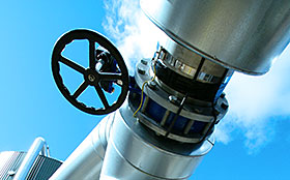Petroleumdriven upturn in PPI
Published:
The last month of the decade gave a large bump in the producer price index (PPI). This increase was mainly driven by the petroleum sector, while the electricity prices pushed in the other direction.
- Full set of figures
- Producer price index
- Series archive
- Producer price index (archive)
In total, PPI rose by 4.1 percent from November to December 2019. The increase for petroleum came in close to all segments of production. Extraction of both crude oil and natural gas had price increases in December, as had services related to these industries, according to new figures from the Producer price index. Furthermore, the prices on refined petroleum products continued the upward trend they have had in the last months. The picture for manufacturing industries outside the refining industry, saw a bit of uneven price developments, and their total index was almost flat. As a negative contributor here, one can mention the metal industry, while the export prices on seafood pulled in the opposite direction.
Lower electricity prices
The aforementioned price increase for petroleum, naturally gave an upturn for the prices on energy goods, whose index ended at a positive 7.7 percent. However, this was somewhat dampened by decreasing electricity prices. Because of windy conditions, wind power production increased in both Norway and the rest of Scandinavia. This was contributary to the electricity prices having a negative development throughout Advent and Christmastide.
Figure 1. Price index. 2015=100
| PPI total | Electricity, gas and steam | |
| Jan. 2015 | 100 | 122.49 |
| feb.15 | 102.13 | 117.51 |
| mar.15 | 103.47 | 108.78 |
| April 2015 | 103.49 | 106.99 |
| mai.15 | 103.43 | 99.6 |
| jun.15 | 103.74 | 82.8 |
| July 2015 | 101.35 | 71.06 |
| aug.15 | 97 | 79.74 |
| sep.15 | 96.82 | 89.29 |
| Oct. 2015 | 97.37 | 104.39 |
| nov.15 | 97.79 | 114.53 |
| des.15 | 93.42 | 102.82 |
| Jan. 2016 | 89.25 | 140.55 |
| feb.16 | 86.9 | 110.19 |
| mar.16 | 88 | 115.89 |
| April 2016 | 88.66 | 115.7 |
| mai.16 | 91.09 | 117.23 |
| jun.16 | 93.67 | 126.9 |
| July 2016 | 94.05 | 124.29 |
| aug.16 | 92.4 | 121.98 |
| sep.16 | 90.95 | 122.56 |
| Oct. 2016 | 92.97 | 145.39 |
| nov.16 | 95.3 | 166.86 |
| des.16 | 100.2 | 146.2 |
| Jan. 2017 | 100.52 | 140.91 |
| feb.17 | 103.25 | 143.2 |
| mar.17 | 102.18 | 140.41 |
| April 2017 | 100.04 | 137.75 |
| mai.17 | 99.22 | 137.86 |
| jun.17 | 96.69 | 126.42 |
| July 2017 | 95.71 | 130.31 |
| aug.17 | 96.12 | 133.24 |
| sep.17 | 98.87 | 146.07 |
| Oct. 2017 | 101.31 | 137.8 |
| nov.17 | 104.59 | 153.48 |
| des.17 | 107.57 | 154.51 |
| Jan. 2018 | 110.93 | 158.32 |
| feb.18 | 108.11 | 177.4 |
| mar.18 | 108.66 | 190.39 |
| April 2018 | 112.25 | 178.11 |
| mai.18 | 113.59 | 164.68 |
| jun.18 | 116.08 | 196.67 |
| July 2018 | 117.32 | 218.38 |
| aug.18 | 117.96 | 220.54 |
| sep.18 | 119.71 | 213.61 |
| Oct. 2018 | 124.06 | 197.43 |
| nov.18 | 120.18 | 213.99 |
| des.18 | 115.93 | 227.35 |
| Jan. 2019 | 116.31 | 235.65 |
| feb.19 | 116.82 | 222.73 |
| mar.19 | 114.41 | 213.82 |
| April 2019 | 115.21 | 211.05 |
| mai.19 | 114.07 | 208.25 |
| jun.19 | 108.53 | 191.47 |
| July 2019 | 107.17 | 200.92 |
| aug.19 | 106.89 | 205.83 |
| sep.19 | 106.91 | 200.29 |
| Oct. 2019 | 107.02 | 209.52 |
| nov.19 | 108.84 | 219.09 |
| des.19 | 113.34 | 209.79 |
Oil, gas and petroleum products decreased PPI between 2018 and 2019
Contrasting the monthly index for December, PPI fell by 3.6 percent from 2018 to 2019. This was opposed to the yearly increase being almost 15 percent the year before. The downturn in 2019 comes mainly from price drops between 2018 and 2019 on both crude oil and natural gas, which fell by 2.2 and 33.1 percent respectively. This decrease was especially a feature of the first half of 2019, while the second half saw more of a fluctuating picture. An abundance of natural gas in Europe was the main cause of this notable development in 2019.
In the refining industry, the yearly decrease was at 8.8 percent, compared to a yearly increase of 25.6 percent the year before.
The prices on electricity increased by 7.3 percent between 2018 and 2019. This was significantly lower than the year before, when prices hit record levels, with an increase at around 40 percent in 2018. Even though this growth in 2019 was markedly lower than in 2018, electricity prices are still much higher than the historical low levels of 2015.
The yearly change in PPI without these energy goods concluded at an increase of 3.1 percent.
Contact
-
Elisabeth Mælum
-
Håvard Georg Jensen
-
Kristin Johansen
-
Statistics Norway's Information Centre

